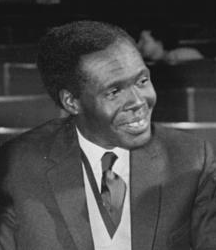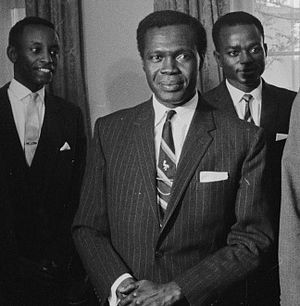Milton Obote facts for kids
Quick facts for kids
Milton Obote
|
|
|---|---|

Obote in 1960
|
|
| 2nd President of Uganda | |
| In office 17 December 1980 – 27 July 1985 |
|
| Vice President | Paulo Muwanga |
| Preceded by | Presidential Commission |
| Succeeded by | Bazilio Olara-Okello |
| In office 15 April 1966 – 25 January 1971 |
|
| Vice President | John Babiiha |
| Preceded by | Edward Mutesa (non-executive) |
| Succeeded by | Idi Amin |
| 2nd Prime Minister of Uganda | |
| In office 30 April 1962 – 15 April 1966 |
|
| Monarch | Elizabeth II (until 1963) |
| Preceded by | Benedicto Kiwanuka (non-executive) |
| Succeeded by | None (post abolished) |
| Personal details | |
| Born |
Apollo Milton Obote
28 December 1925 Akokoro, Apac District, Uganda Protectorate |
| Died | 10 October 2005 (aged 79) Johannesburg, South Africa |
| Political party | Uganda People's Congress |
| Spouse | Miria Obote |
| Children | 5 |
Apollo Milton Obote (born December 28, 1925 – died October 10, 2005) was an important political leader in Uganda. He helped Uganda gain its independence from British rule in 1962. After independence, he served as the Prime Minister of Uganda from 1962 to 1966. Later, he became the second president of Uganda from 1966 to 1971. He was president again from 1980 to 1985.
In 1960, Obote started the Uganda People's Congress (UPC) political party. This party was very important in helping Uganda become independent from the United Kingdom in 1962. He then became prime minister by forming a team with the Kabaka Yekka movement. Their leader, King Mutesa II, became president.
Later, Obote had disagreements with Mutesa. In 1966, Obote removed Mutesa from power and declared himself president. He then created a government where the UPC was the only official party. Obote tried to introduce socialist ideas, but Uganda faced problems like corruption and food shortages during his time.
In 1971, Idi Amin took over the government in a military takeover. Obote went to live in Tanzania. He was re-elected president in 1980, a year after Amin was removed from power. His second time as president ended after a long conflict called the Ugandan Bush War. He was removed from power again in 1985 and spent the rest of his life living outside Uganda.
Contents
Early Life and Political Beginnings
Milton Obote was born in Akokoro village, located in the Apac district of northern Uganda. He was the third of nine children. His father was a chief of the Oyima clan, part of the Lango ethnic group.
Obote started school in 1940 at a Protestant Missionary School in Lira. He later attended Gulu Junior Secondary School and Busoga College. He then went to Makerere University. Obote wanted to study law, but it was not taught there. So, he studied general arts, including English and geography. At Makerere, he became very good at public speaking. He might have left the university after a student strike.
After university, Obote worked in Buganda in southern Uganda. Then he moved to Kenya, where he worked in construction. In Kenya, Obote became involved in the movement for national independence. When he returned to Uganda in 1956, he joined the Uganda National Congress (UNC) political party. In 1957, he was elected to the colonial Legislative Council. In 1959, the UNC split. Obote's group joined with the Uganda People's Union to form the Uganda People's Congress (UPC).
Obote represented the UPC at the Ugandan Constitutional Conference in 1961. This meeting was held at Lancaster House in London. The British Government organized the conference to prepare Uganda for independence.
Becoming Prime Minister
Before Uganda's independence elections, Obote formed a partnership with the Buganda royalist party, Kabaka Yekka. Together, these two parties had enough votes in Parliament. This allowed Obote to become Prime Minister in 1962. He officially took the role on April 25, 1962. Sir Walter Coutts, who was the Governor-General of Uganda, appointed him.
The next year, the role of Governor-General was replaced by a ceremonial president. This president was elected by the parliament. Mutesa, the Kabaka (King) of Buganda, became the ceremonial President. Obote remained the main executive prime minister.
In January 1964, soldiers at the military barracks in Jinja had a mutiny. Jinja is Uganda's second-largest city and home to the 1st Battalion of the Uganda Army. Similar mutinies happened in two other East African countries. All three countries asked for help from the British military. Before the British arrived, Obote sent his defense minister, Felix Onama, to talk with the soldiers. Onama was held hostage. He agreed to many demands, including higher pay for the army. Many officers, including Idi Amin, were quickly promoted.
In 1966, Obote faced accusations related to a gold smuggling plot. Idi Amin, who was then a deputy commander in the army, was also involved. When the Parliament asked for an investigation into Obote, he took strong action. In March 1966, he suspended the constitution and declared himself President. He gave himself almost unlimited power. Several members of his government were arrested without charge. Obote also ordered an attack on Mutesa's palace. Mutesa had to flee the country. In 1967, Obote's power became even stronger. The parliament passed a new constitution that removed the federal system and created an executive presidency.
First Time as President
On December 19, 1969, someone tried to assassinate Obote. As he was leaving a UPC meeting in Kampala, a man named Mohamed Sebaduka shot him. The bullet hit Obote in the face, breaking two teeth. Another person, Yowana Wamala, threw a grenade, but it did not explode. Both attackers escaped at first but were later arrested. Investigators also arrested several members of the Democratic Party, which was the main opposition party. They accused former prime minister Benedicto Kiwanuka of planning the attack.
After this event, all opposition political parties were banned. This made Obote an almost absolute ruler. A state of emergency was in place for much of this time. Many political opponents were jailed without trial. His secret police, the General Service Unit, was led by Obote's cousin.
Between 1969 and 1970, Obote published papers explaining his political and economic plans. His idea of socialism was called the "Move to the Left." In 1970, the government took a 60% share in major private companies and banks. During Obote's rule, there were problems with corruption. Food shortages also caused prices to rise sharply. Challenges for Indian traders also contributed to these rising prices.
In January 1971, Obote was visiting Singapore for a meeting. While he was away, the army overthrew his government. Idi Amin became the new President. Many Ugandans were happy when Obote's government fell.
First Time in Exile
After the military takeover, Obote went to Tanzania. The President of Tanzania, Julius Nyerere, was a close friend of Obote. Nyerere supported Obote's socialist ideas. Tanzania offered Obote training camps to organize a rebel army. Many of Obote's supporters also went to Sudan for safety and training. From early 1971, Obote began to build a rebel army.
However, Obote found it hard to get support from other Ugandans. Many opposition groups preferred Amin over Obote. There were also disagreements and tensions within Obote's own groups. In 1972, the Sudanese government signed an agreement with Amin. This forced Obote and his followers to leave Sudan, which weakened them. Obote was only able to gather about 1,000 fighters, and many were not well trained.
As tensions grew between Tanzania and Uganda, Nyerere finally allowed an invasion. Even some exiles who disagreed with Obote, like Yoweri Museveni's group, joined the plan. The 1972 invasion of Uganda by Obote's rebel group was a military failure. This failure caused more tension among the anti-Amin forces. Obote blamed Museveni for not having a strong underground network in southern Uganda. This network was supposed to cause a popular uprising, but it did not happen. This failure led to a lasting disagreement between Obote and Museveni.
After the failed invasion, the Tanzanian government officially stopped supporting anti-Amin rebels. Obote and his close friends moved to Dar es Salaam. Many of them became teachers, lawyers, or doctors. His ordinary fighters were moved to Tabora to become coffee farmers.
The Tanzanian government quietly allowed anti-Amin activities to continue as long as they were secret. Obote kept a low profile for several years. He lived off a Tanzanian pension. He rarely gave interviews or met with other opposition figures. Most of the time, he stayed at a comfortable beach house near Nyerere's home. Despite his quiet life, Obote actively planned to overthrow Amin. He set up a small rebel force of 100 fighters. They sometimes launched raids into Uganda from Kenya. He also created his own "navy" of six boats. These boats smuggled coffee on Lake Victoria to fund his political and military activities. This "navy" also built a secret network inside Uganda. Obote hoped to slowly weaken Amin's government. However, his rebel network did not achieve much. His movement could not remove important followers of Amin. Also, Obote was still not popular with most Ugandans. Even those who opposed Amin did not want Obote to return to power.
Second Time as President
In 1979, Idi Amin was removed from power by Tanzanian forces and Ugandan exiles. By 1980, Uganda was led by a temporary Presidential Commission. The chairman of this commission was Paulo Muwanga, a close friend of Obote. Muwanga had briefly been the acting President of Uganda in May 1980.
The elections in 1980 were won by Obote's Uganda People's Congress (UPC) party. However, the opposition parties believed the elections were unfair. This led to a guerrilla war started by Yoweri Museveni's National Resistance Army (NRA) and other military groups. Obote also held the title of Minister of Finance.
In 1983, Obote's government launched a military operation called Operation Bonanza. This operation led to many people losing their homes and lives. The blame for this was often placed on people from northern Uganda. This increased tensions between different regions in the country. It is estimated that many people died as a result of fighting between Obote's Uganda National Liberation Army (UNLA) and the rebel groups.
On July 27, 1985, Obote was removed from power again. Just like in 1971, his own army commanders overthrew him in a military takeover. This time, the commanders were Brigadier Bazilio Olara-Okello and General Tito Okello. These two men briefly ruled Uganda through a Military Council. However, after a few months, Museveni's NRA took control of the country. By July 1985, it was estimated that Obote's government was responsible for many civilian deaths across Uganda. Problems were especially noticeable in an area called the Luweero Triangle.
Later Life and Death
After being removed from power for the second time, Obote first went to Kenya. He then moved to Zambia. For some years, people thought he might return to Ugandan politics. However, in August 2005, he announced that he would step down as the leader of the UPC party. In September 2005, there were reports that Obote would return to Uganda before the end of the year.
On October 10, 2005, Milton Obote died from kidney failure in a hospital in Johannesburg, South Africa.
Milton Obote was given a state funeral in the Ugandan capital, Kampala, in October 2005. President Museveni, who had been Obote's political opponent, attended the funeral. This surprised and was appreciated by many Ugandans. However, some groups, like the people who survived the events in the Luweero Triangle, were upset that Obote received a state funeral.
Obote was survived by his wife and five children. On November 28, 2005, his wife, Miria Obote, was elected president of the UPC party.
See also
 In Spanish: Milton Obote para niños
In Spanish: Milton Obote para niños



